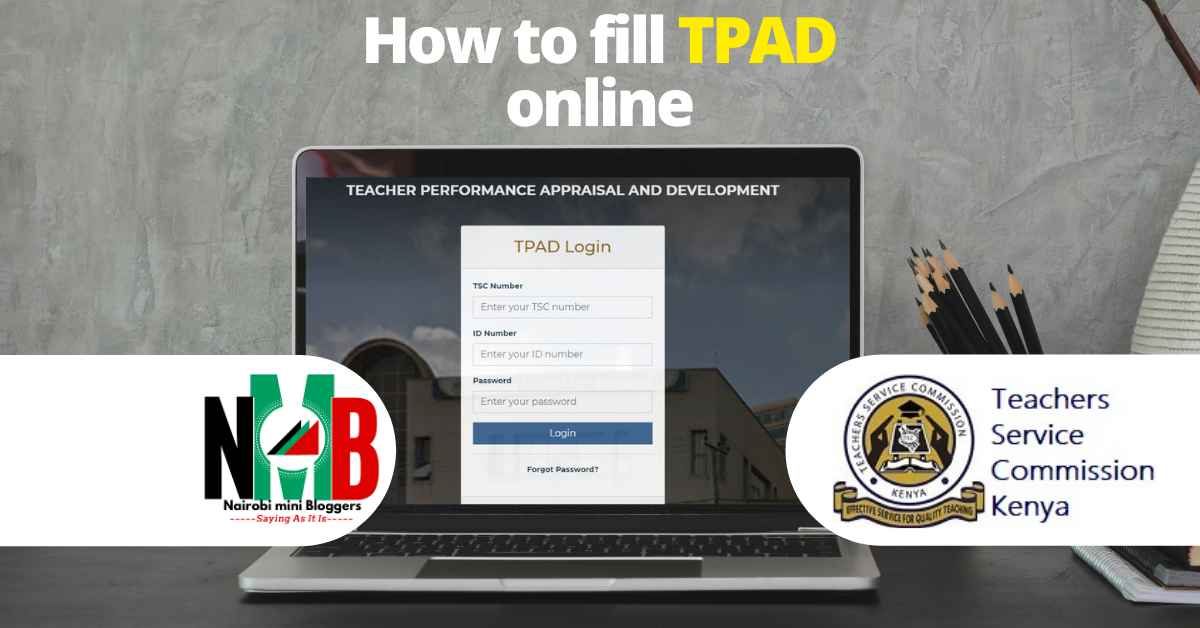The Teacher Performance Appraisal and Development (TPAD) is a tool used by the Teachers Service Commission (TSC) in Kenya to assess and evaluate the performance of teachers in primary and secondary schools. The TPAD system was introduced by the TSC as part of its efforts to improve the quality of education in the country. In this article, I will take you through how to fill TSC Tpad online.
Under the TPAD system, teachers are expected to set performance targets at the beginning of each academic year and then work towards achieving those targets.
The TPAD system also includes regular classroom observations, self-assessments, and assessments by school heads or principals.
The data collected through the TPAD system is used by the TSC to identify areas of weakness among teachers and provide support and training to improve their performance.
The TPAD system is an important tool in ensuring that teachers are accountable for their performance and that they are meeting the required standards.
It also helps to identify areas where teachers may need additional support and training to improve their teaching skills.
How To Fill TSC Tpad Online
The Teacher Performance Appraisal and Development (TPAD) is an online platform that is used by the Teachers Service Commission (TSC) in Kenya to evaluate the performance of teachers in primary and secondary schools.
The TPAD system is designed to help teachers improve their teaching skills and meet the required standards. In this article, we will discuss how to fill TSC TPAD online.
Step 1: Log in to the TPAD portal
To start the TPAD evaluation process, you need to log in to the TPAD portal using your TSC number and password.
You can access the portal by visiting the TSC website and clicking on the TPAD icon on the top right-hand corner of the homepage.
Step 2: Update personal details
Once you have logged in, the first thing you need to do is update your personal details. This includes your name, TSC number, designation, school name, and the subject you teach.
You should also ensure that your phone number and email address are up to date so that you can receive notifications and updates from the TSC.
Step 3: Set performance targets
The next step is to set your performance targets for the academic year. These targets should be specific, measurable, achievable, relevant, and time-bound.
They should be aligned with the TSC performance indicators and the school’s strategic plan. You can set your performance targets by clicking on the “My Performance Targets” tab on the TPAD portal.
Step 4: Self-assessment
The TPAD system requires teachers to do a self-assessment of their teaching performance. This involves reflecting on your teaching practices and identifying areas of strength and weakness.
You can do your self-assessment by clicking on the “Self-Assessment” tab on the TPAD portal.
Step 5: Classroom observation
One of the key components of the TPAD system is classroom observation. This involves a trained observer (usually the head teacher or principal) coming to your classroom to observe your teaching practices.
The observer will then provide feedback on your performance. To schedule a classroom observation, click on the “Schedule for Observation” tab on the TPAD portal.
Step 6: Lesson plans and schemes of work
The TPAD system requires teachers to upload their lesson plans and schemes of work to the portal.
MUST READ: HOW TO FILE NIL RETURNS USING YOUR PHONE
These documents should be aligned with the curriculum and the school’s strategic plan. You can upload your lesson plans and schemes of work by clicking on the “My Lesson Plans” and “My Schemes of Work” tabs on the TPAD portal.
Step 7: Professional development
The TPAD system also requires teachers to undertake professional development activities to improve their teaching skills.
This can include attending workshops, conferences, and training sessions.
To record your professional development activities, click on the “Professional Development” tab on the TPAD portal.
Step 8: Submitting your evaluation
Once you have completed all the required sections on the TPAD portal, you need to submit your evaluation.
This will allow your head teacher or principal to review your performance and provide feedback. To submit your evaluation, click on the “Submit for Review” tab on the TPAD portal.
Step 9: Review feedback
After you have submitted your evaluation, your head teacher or principal will review your performance and provide feedback.
You should take the feedback seriously and use it to improve your teaching practices. You can access the feedback by clicking on the “My Appraisal Reports” tab on the TPAD portal.
Step 10: Repeat the process
The TPAD system is a continuous process, and teachers are required to evaluate their performance every year. You should use the feedback from the previous year to set new performance targets and improve your teaching practices.
In conclusion, the TPAD system is an important tool that helps to improve the quality of education in Kenya by ensuring that teachers are held accountable for their performance and are continuously improving their teaching practices.
By following the steps outlined above, teachers can effectively fill out the TSC TPAD online, set performance targets, conduct self-assessments, schedule classroom observations, upload lesson plans and schemes of work, record professional development activities, submit their evaluations for review, and review feedback provided by their head teachers or principals.
It is important for teachers to take the TPAD evaluation process seriously and to use the feedback provided to improve their teaching practices.
This will not only improve their performance but will also contribute to the overall improvement of the quality of education in Kenya. It is also important to note that the TPAD system is just one of the many tools that teachers can use to improve their teaching skills.
Teachers should also take advantage of other training and development opportunities that are available to them, including attending workshops, conferences, and training sessions.
'Want to send us a story? Submit to NAIROBIminiBLOGGERS via our Email nairobiminiblogger@gmail.com'

Drop Your Comments, What do you think About The Article?